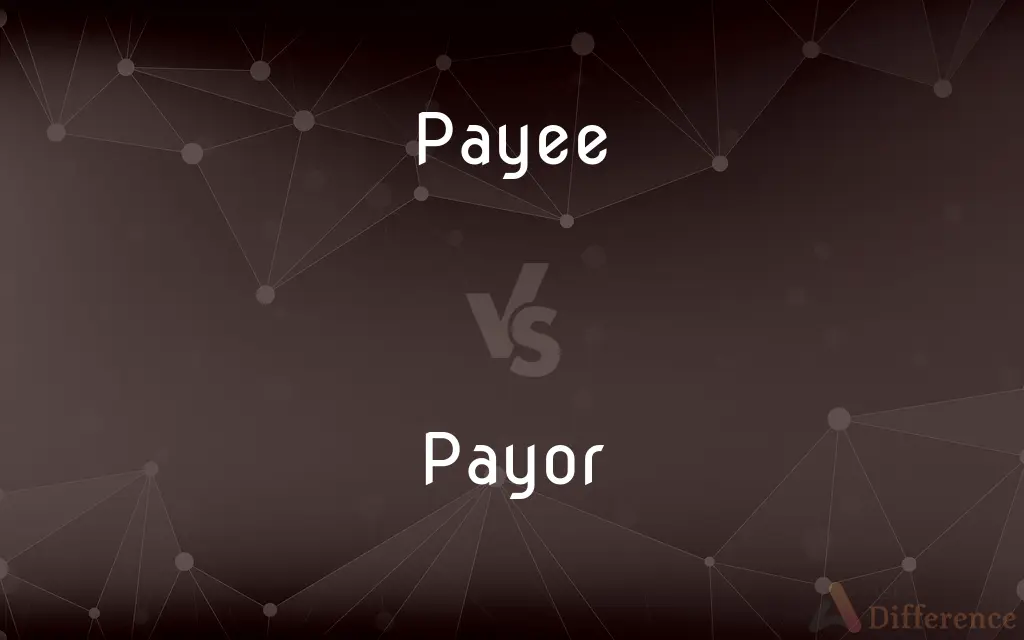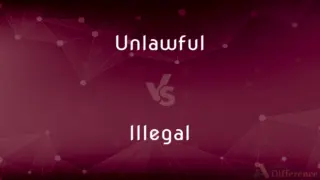Payee vs. Payor — What's the Difference?
Edited by Tayyaba Rehman — By Fiza Rafique — Updated on October 29, 2023
A "Payee" is the party receiving funds, while a "Payor" (or "Payer") is the party making the payment. Both terms are used in financial transactions to denote roles.

Difference Between Payee and Payor
Table of Contents
ADVERTISEMENT
Key Differences
In any financial transaction, there are always two key entities: the Payee and the Payor. The Payee is the entity that receives the funds. This could be an individual, business, or other organization. On the other hand, the Payor is the entity that provides or releases the funds, essentially initiating the payment.
When it comes to checks, the name that's written on the check, i.e., the one to whom the check is addressed, is the Payee. This indicates that the Payee is the intended recipient of the money. The Payor, in this context, is the individual or entity whose bank account will be debited when the check is cashed or deposited.
If we delve into the world of bills and invoices, the Payee is the one who sends the bill. It could be a utility company, a landlord, or any service provider. This Payee expects to receive a certain amount for services or goods provided. The Payor is the individual or business responsible for settling the bill, ensuring that the Payee gets their due.
In the realm of electronic transactions, the dynamics of Payee and Payor remain constant. The Payee is still the party receiving the electronic transfer of funds, and the Payor is the one sending it. It's essential to ensure the correct details for the Payee to ensure the funds reach the right place. Meanwhile, the Payor often needs to authorize the transaction, especially if it's a sizable amount.
Simplifying further, in any given payment situation, the Payee stands at the receiving end of the transaction spectrum, and the Payor is at the initiating or sending end. Both roles are crucial to complete any monetary transaction successfully.
ADVERTISEMENT
Comparison Chart
Role
Receives the funds
Provides or releases the funds
Context of Checks
Name written on the check
Account holder whose account is debited
In terms of Bills
Sends the bill or invoice
Settles the bill or invoice
Electronic Transactions
Receives electronic transfer of funds
Sends or authorizes the electronic funds
Transaction Spectrum
Stands at the receiving end
Is at the initiating or sending end
Compare with Definitions
Payee
Party receiving payment.
The payee's name is at the top of the invoice.
Payor
Entity from whose account funds are drawn.
The payor's account was debited for the purchase.
Payee
Entity to whom money is to be paid.
Ensure the payee details are correct.
Payor
One who settles an invoice or bill.
The payor received a discount for early payment.
Payee
Name written on a check.
The payee should endorse the back of the check.
Payor
Individual or organization sending money.
The payor initiated the bank transfer.
Payee
Individual or entity expecting payment.
The payee sent a reminder for overdue funds.
Payor
Entity that provides or releases funds.
The payor's authorization is needed for large transactions.
Payee
Recipient of funds in a transaction.
The payee received the wire transfer.
Payor
Party responsible for making a payment.
The payor settled the bill promptly.
Payee
One to whom money is paid.
Payor
Payer.
Payee
One to whom money is paid.
Payor
Variant of payer.
Payee
The person to whom money is to be, or has been, paid; the person named in a bill or note, to whom, or to whose order, the amount is promised or directed to be paid. See Bill of exchange, under Bill.
Payor
One who makes a payment.
Payee
A person to whom money is paid
Payor
See Payer.
Common Curiosities
Can a single entity be both a payee and a payor?
Yes, depending on transactions, one can receive (as a payee) and send money (as a payor).
Can a payee refuse payment from a specific payor?
Yes, a payee can decline a transaction if they suspect fraud or other issues.
In a check transaction, who bears the responsibility if something goes wrong?
Both payee and payor have responsibilities, but the payor's bank usually has the final say in disputes.
What happens if a payor's account doesn't have sufficient funds?
The transaction may be declined or result in overdraft fees, depending on the account terms.
How does a payee verify the authenticity of a payor’s check?
Through bank verification, checking signatures, and other anti-fraud measures.
Is "payor" the same as "payer"?
Yes, "payor" and "payer" mean the same, but "payor" is less common.
Who usually incurs transaction fees?
Often the payor, but it depends on the transaction type and agreement between parties.
Can the names of the payee and payor be the same on a check?
Yes, one can write a check to oneself, being both the payee and the payor.
Can a payor stop a payment?
Yes, a payor can usually stop a check or scheduled transaction before it's processed.
How do payee and payor maintain transaction privacy?
By following data protection guidelines, using secure channels, and not sharing unnecessary details.
Can a payee charge interest or fees for late payments?
If agreed upon in advance or stipulated in contracts, then yes.
Do electronic transfers make the roles of payee and payor more secure?
Generally, yes, due to added verification and encryption measures.
Who needs to report large transactions to tax authorities?
Both the payee and payor might have reporting obligations, depending on local laws.
What's the risk for a payee accepting a post-dated check?
The payor's account might not have sufficient funds on the specified date.
How does a payor typically authorize a recurring payment?
By giving the payee permission, often in writing or electronically, to draw funds regularly.
Share Your Discovery

Previous Comparison
Contiguous vs. Continuous
Next Comparison
Unlawful vs. IllegalAuthor Spotlight
Written by
Fiza RafiqueFiza Rafique is a skilled content writer at AskDifference.com, where she meticulously refines and enhances written pieces. Drawing from her vast editorial expertise, Fiza ensures clarity, accuracy, and precision in every article. Passionate about language, she continually seeks to elevate the quality of content for readers worldwide.
Edited by
Tayyaba RehmanTayyaba Rehman is a distinguished writer, currently serving as a primary contributor to askdifference.com. As a researcher in semantics and etymology, Tayyaba's passion for the complexity of languages and their distinctions has found a perfect home on the platform. Tayyaba delves into the intricacies of language, distinguishing between commonly confused words and phrases, thereby providing clarity for readers worldwide.















































